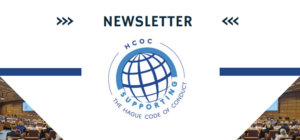The HCoC: relevance to African states
Institute for Security Studies - Africa
Policy Brief 90
The Hague Code of Conduct against Ballistic Missile Proliferation (HCoC), which came into effect on 25 November 2002, aims to strengthen efforts to curb ballistic missile proliferation worldwide, thereby supplementing the Missile Technology Control Regime, which restricts access to technologies needed to develop such systems. Ballistic missiles are the favoured delivery vehicles for weapons of mass destruction and therefore have a destabilising effect on regional and global security. This brief provides an overview of the HCoC, examines its relevance for African states and outlines the benefits that can be derived by subscribing to its general principles, commitments and confidence-building measures.
SEPTEMBER 2016
Nicolas Kasprzyk, Emmanuelle Maitre, Xavier Pasco and Noel Stott
Overview of the development of the HCoC
“To signal the international community’s concern over the proliferation of ballistic missiles, the HCoC consists of a set of general principles, modest commitments and limited confi dence-building measures aimed at delegitimising ballistic missile proliferation, and at increasing transparency and confidence among states”

The Hague Code of Conduct against Ballistic Missile Proliferation (HCoC) came into effect on 25 November 2002. Established at a conference hosted by the Netherlands and attended by 93 states, the code aims to contribute to international peace and security by strengthening global efforts to curb ballistic missile proliferation.1 Because ballistic missiles have a high arching trajectory, they are the favoured delivery vehicles for weapons of mass destruction (WMD), such as nuclear warheads.
At the end of the 1990s, steps taken by the Democratic People’s Republic of Korea (North Korea) and the Islamic Republic of Iran, among others, to develop ballistic missile programmes led to the members of the MTCR reassessing their strategy for curbing ballistic missile proliferation by restricting access to related technologies.
The Missile Technology Control Regime (MTCR), which was established in 1987, plays an important part in limiting the proliferation of delivery systems by restricting the exports of missiles capable of carrying a 500 kg payload at least 300 km, and of missiles that deliver chemical, biological or nuclear weapons, as well as related technologies. The 34 member states of the MTCR maintain vigilance over the transfer of missile equipment, material and related technologies that could be used for producing systems capable of delivering WMD.2
As a means of supplementing these trade limitations, and with the backing of the European Union (EU), the MTCR members proposed a politically binding code (the International Code of Conduct against Ballistic Missile Proliferation [ICoC]) – now called the Hague Code of Conduct against Ballistic Missile Proliferation – to the international community to encourage states to be more transparent about their ballistic missiles and civilian space programmes. The code of conduct was also intended to serve as a warning system before launches are conducted. The proposed code illustrated the conviction, widely shared at the time of its adoption, that multilateralism could be a useful tool to curb the proliferation of WMD. This was a belief that had led to the adoption of the Comprehensive Nuclear-Test-Ban Treaty (CTBT) by the UN General Assembly on 10 September 1996, to the entry into force of the Convention on the Prohibition of the Development, Production, Stockpiling and Use of Chemical Weapons and on Their Destruction (CWC) on 29 April 1997, and to the indefinite extension of the Treaty on the Non-Proliferation of Nuclear Weapons (NPT) on 11 May 1995.
While the CWC and the 1972 Convention on the Prohibition of the Development, Production and Stockpiling of Bacteriological (Biological) and Toxin Weapons and on their Destruction (or the Biological and Toxin Weapons Convention, BTWC) both ban an entire category of weapons, and the NPT commits states parties to eventual nuclear disarmament, the same technologies used in ballistic missiles can also be used for peaceful purposes, such as civilian rockets, satellite launches and space exploration.
As ballistic missiles are capable of carrying various types of conventional weapons, and not only WMD, they are also considered by some states as legitimate weapons for their national security. To take this into account, it was agreed that normative measures with regard to these systems would need to be decided on and that a relatively consensual, universal instrument based on voluntary implementation would be drafted. To signal the international community’s concern over the proliferation of ballistic missiles, the HCoC consists of a set of general principles, modest commitments and limited confi dence-building measures aimed at delegitimising ballistic missile proliferation, and at increasing transparency and confidence among states.3 (See the annex for the full text of the HCoC.)
The MTCR and HCoC are thus both based on an informal political understanding among states seeking to limit the proliferation of missiles and missile technology. They depend for their enforcement on either a common export policy applied to an integral list of items, voluntary political compliance, or a self-imposed code of conduct, rather than being subject to treaties sanctioned by international law.4
1 For the Hague Code of Conduct, see www.hcoc.at/ or https://cms.bmeia.at/en/foreign-ministry/foreign-policy/disarmament/weapons-of-mass-destruction/hcoc.html.
2 For the Missile Technology Control Regime, see www.mtcr.info/english/FAQ-E.html.
3 See www.hcoc.at/ or https://cms.bmeia.at/en/foreign-ministry/foreign-policy/disarmament/weapons-of-mass-destruction/hcoc.html.
4 Bernd Kubbig and Sven Eric Fikenscher (eds), Arms control and missile proliferation in the Middle East, London: Routledge, 2012.





